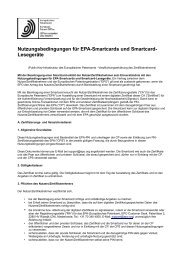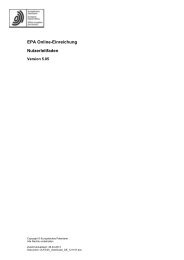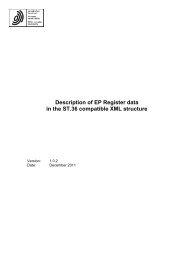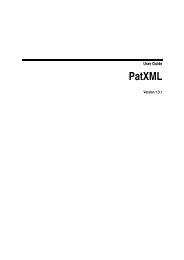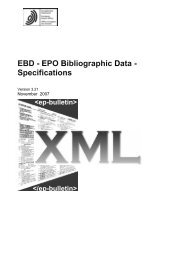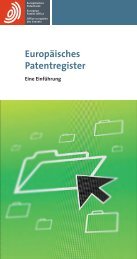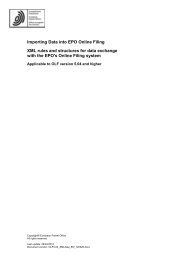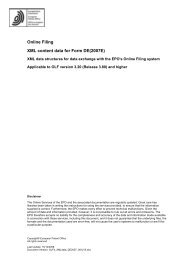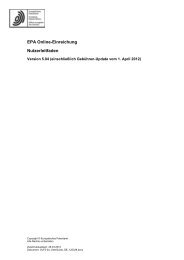Character set & entity references - EPO
Character set & entity references - EPO
Character set & entity references - EPO
Create successful ePaper yourself
Turn your PDF publications into a flip-book with our unique Google optimized e-Paper software.
<strong>EPO</strong> <strong>Character</strong> <strong>set</strong> and <strong>entity</strong> <strong>references</strong> Version 1.0a, October 1995<strong>Character</strong> <strong>entity</strong> <strong>references</strong>As stated in the introduction an <strong>entity</strong> reference may be used wherever a character is required that isnot present in the character code <strong>set</strong> shown above.A problem can arise when a character that has been assigned special significance in the SGMLdeclaration, in the reference concrete syntax to be precise, occurs as part of the text. A particular caseis where the subject matter contains mathematical expressions in which "less than" () signs frequently occur. These are also the start and end characters for SGML tags (accordingto the declaration in WIPO ST.32). Therefore, within the document instance, when these charactersoccur they must be entered as <strong>entity</strong> <strong>references</strong>; otherwise any data between these characters might betreated as an SGML tag.Such characters most frequently used in the implementation of SGML markup, in the <strong>EPO</strong>, are "lessthan", "greater than" and "ampersand". When encountered in a document as text data they are to bereplaced as necessary by the <strong>entity</strong> <strong>references</strong> listed below.Throughout an entire document, except as the start indicator of an <strong>entity</strong> reference, the 'ampersand'sign is to be coded:(&) ampersand<strong>&</strong>;Throughout an entire document, except as the delimiters of a generic code, the "less than" and "greaterthan" signs are to be coded:() greater than >The fonts used during the composition of the <strong>entity</strong> reference table below can only give an impressionof the final character required for printing. The actual format of the characters may differ onpublication. Those <strong>entity</strong> <strong>references</strong> with (<strong>EPO</strong>) following the description have been created by the<strong>EPO</strong> and are non-ISO <strong>entity</strong> <strong>references</strong>. These <strong>entity</strong> <strong>references</strong> are contained in the epopat.ent filereferenced in the <strong>EPO</strong> DTD, see also Annexes 2 and 3.Page 12



